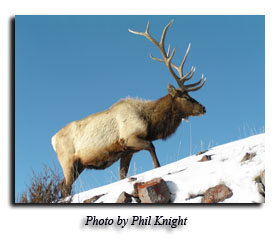
A Magnificant Mountainscape
 Pre-Cambrian "basement rocks" of gneiss and schist are covered by a complex of Paleozoic sedimentary rocks formed at the bottom of a shallow ancient sea that covered Montana, and by expansive Absaroka volcanic rocks dating back to Eocene lava flows. The Gallatin uplift has been eroded by flowing water and sculpted by Pleistocene glaciers into a scenic realm of u-shaped mountain stream valleys, high cirque basins, sharp peaks and ridges, and alpine tundra plateaus.
Pre-Cambrian "basement rocks" of gneiss and schist are covered by a complex of Paleozoic sedimentary rocks formed at the bottom of a shallow ancient sea that covered Montana, and by expansive Absaroka volcanic rocks dating back to Eocene lava flows. The Gallatin uplift has been eroded by flowing water and sculpted by Pleistocene glaciers into a scenic realm of u-shaped mountain stream valleys, high cirque basins, sharp peaks and ridges, and alpine tundra plateaus.
The vegetation mosaic is rich and diverse: a complex of Douglas-fir, aspen, sagebrush steppe and foothills prairie grace the lower elevations, with scattered juniper and limber pine. Higher, aspen and Douglas fir are replaced by lodgepole pine, Englemann spruce and subalpine fir, mixed with rich mountain meadows. Near tree line, whitebark pine dominates many sites, and well-developed alpine tundra characterizes the areas above approximately 9,500 feet. It is this rich mix of different habitats in close proximity to one another in a breathtaking mountain landscape that defines the wild character of these mountains.
This diverse mix of Gallatin Range habitats supports abundant wildlife. In fact, the Gallatins are one of America's great wildlife treasures! Due both to its rich habitat mosaic, its large roadless core and its proximity to Yellowstone, the northern Gallatins support nearly all of the fauna indigenous to the GYE. And the southern Gallatins include some of the best wildlife habitats in Yellowstone Park.
 In other words, the Gallatin Range is a magnificent Rocky Mountain wilderness, pulsating with life and the natural processes that shape life, rugged and resistant to the sometimes harsh geologic and climatic forces that mold it, yet fragile and unnervingly vulnerable to the actions and decisions of those humans who surround it.
In other words, the Gallatin Range is a magnificent Rocky Mountain wilderness, pulsating with life and the natural processes that shape life, rugged and resistant to the sometimes harsh geologic and climatic forces that mold it, yet fragile and unnervingly vulnerable to the actions and decisions of those humans who surround it.